Western Digital Red Review: Are NAS-optimized HDDs Worth the Premium?
by Ganesh T S on August 17, 2012 4:20 PM EST- Posted in
- Storage
- NAS
- Western Digital
Stress Testing and Effects of Prolonged Usage
Readers of our other NAS reviews might be aware that we are in the process of building a NAS testbed capable of testing mult-client scenarios. While the details of the testbed will come in a separate piece next week, we will describe the relevant part of the system in this section. Since the Synology DS211+ performed the best amongst the three tested NAS systems and is also officially recommended by WD, we chose it for stress testing. The DS211+ was configured with 2 x 3TB WD Red drives in RAID-1 and connected to a Zyxel GS2200 switch. A dual Xeon workstation was set up to run 12 Windows 7 VMs (each with a dedicated physical disk and a dedicated GbE port connected to the switch). Scripts were set up to do a synchronized data copy from each VM to a Samba share on the DS211+. We paused the scripts after the NAS became 30%, 60% and 90% full to repeat our benchmarks from the previous section. Each 30% step took approximately 15 - 20 hours. A screenshot of the status of the Samba share after the process was completed (90% full) is shown below.
At 90% full, the NAS had more than 7 million files in almost a million folders. 95% of the files were between 0 and 512 KB in size. 1.8% were between 0.5 and 1 MB, 2.8% between 1 and 10 MB, 0.2% between 10 and 100 MB, 0.03% between 100 and 1024 MB, and 360 files were more than 1 GB in size.
The results of running the NASPT / robocopy benchmarks at each stage are provided in the graph below. Note that the NASPT tests were run from one of the VMs in the new testbed, and some of the results could be slightly different from what was obtained with our Summer 2012 NAS testbed.
The above benchmarks show that the performance does degrade (particularly for write intensive benchmarks) as the NAS fills up. However, the big gap that we saw in the raw drive performance (in the HD Tune Pro benchmarks) doesn't seem to be as evident when the disk is being used inside a NAS. In any case, it is always advisable to run any NAS below 90% of the capacity.



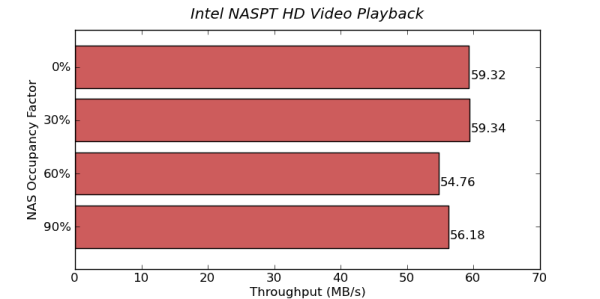
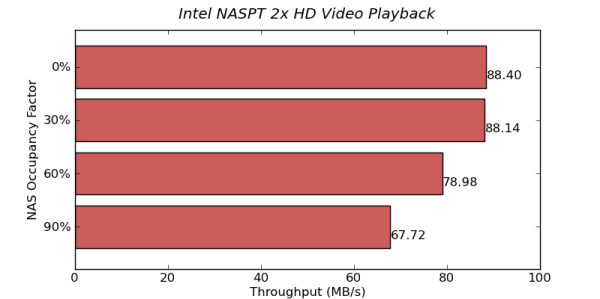
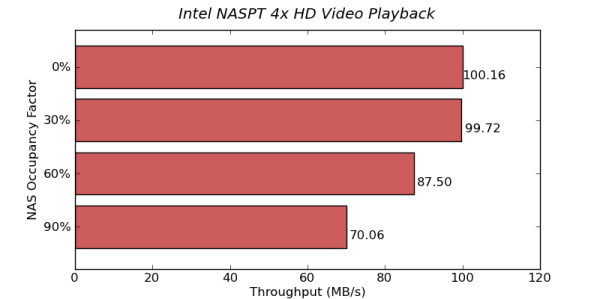
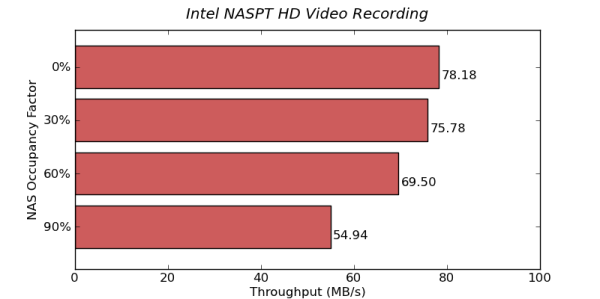
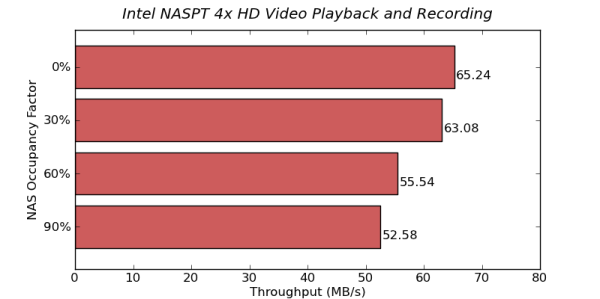
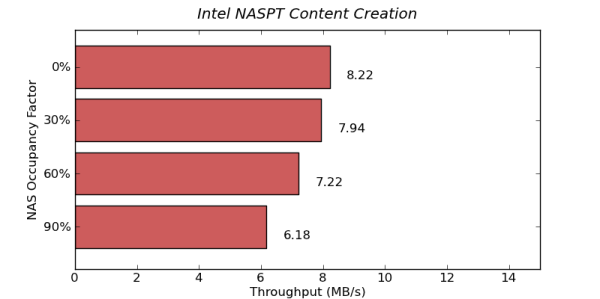
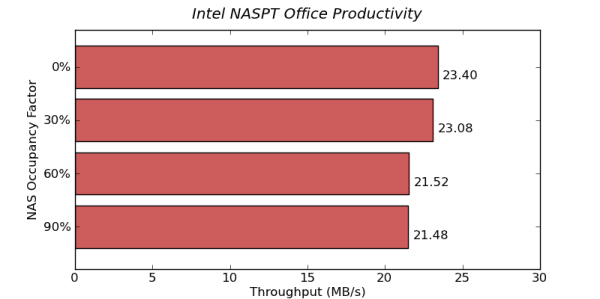
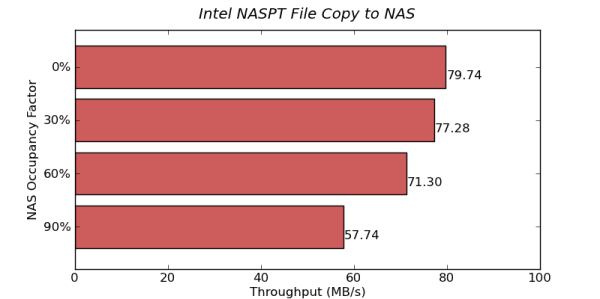
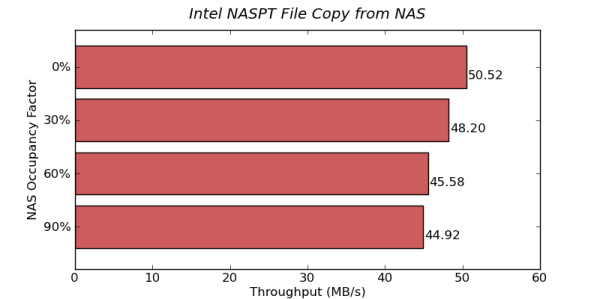
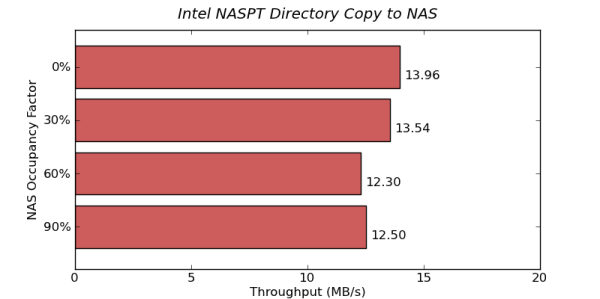
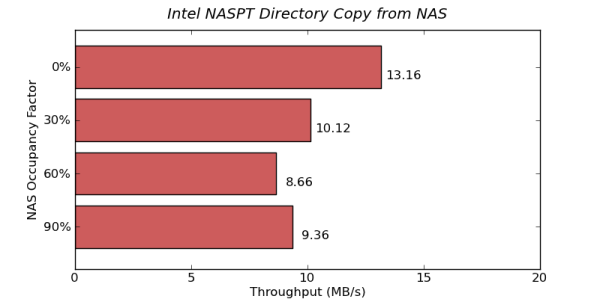
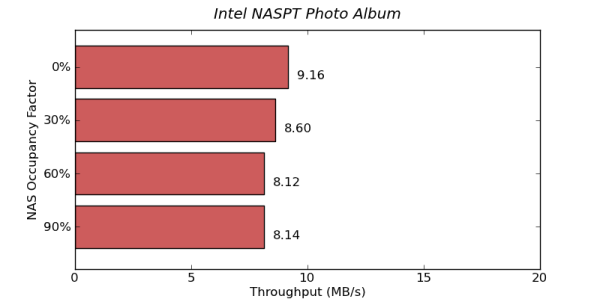
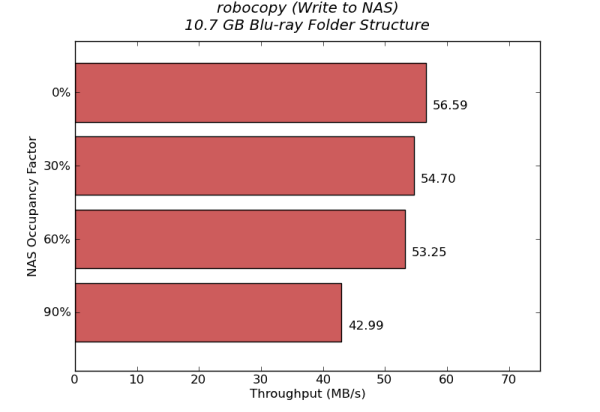
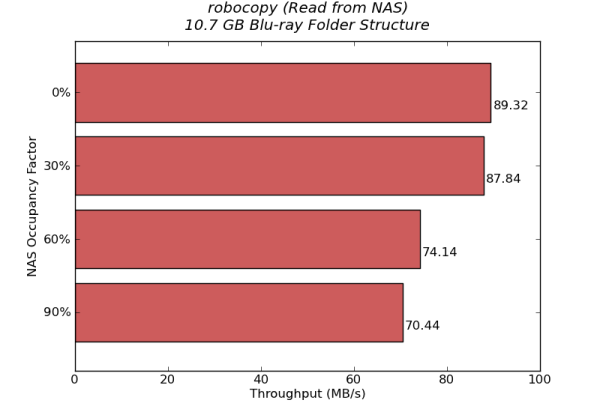








87 Comments
View All Comments
Sivar - Friday, August 17, 2012 - link
"Pretty horrible article, charts are unreadable."I find them easy to read, but if you are having trouble you can click on each to scale it up in size. Ganesh even saved them as PNG, and kept the colors simple (as is best to do with PNG/GIF), so the fine sizes are very small and the charts look as intended (no JPEG artifacts).
"Actual writing is difficult to read, please be more concise."
I found the writing to be of generally high quality. Perhaps you should offer some examples of overly verbose writing. I'm not claiming there aren't any examples, just that providing some will help make your criticisms more constructive. :)
"Oh and crap like "IT departments have been tempted to use consumer drives". Absolute bullshit. If the author has done this he should be fired from his job."
No, it is not.
Your experience may be limited to well-funded, large IT organizations. I have worked in both poorly funded (school / non-profit, etc.) and "by the book" well-funded companies, like the one I am in now.
I have personally used non-enterprise drives in 24/7 RAID arrays. I researched them first, of course. Some even support, or supported, TLER through special utilities. My own home server has eight Samsung F4s that have worked perfectly for almost 3 years (not that a single data point is very useful).
When you have a smaller budget than list of requirements, you make due, and document the reasons for the decisions made. It's part of real-world IT -- not everyone can afford a NetApp storage rack!
Wwhat - Friday, August 17, 2012 - link
To be fair, if you compare the scaled and full sizes of the pictures and see how they don't employ the full available width (compared to the text) when scaled it does seem a bit poorly done, it would have been better to make the pictures slightly wider and slightly less tall and then have them unscaled I think, you'd have simplified things and have them sharp and clear and still not use more bandwidth or require more speed from the reader's internet.yyrkoon - Friday, August 17, 2012 - link
Well Sivar, it is not even that simple. Which you probably know better than I.Department heads for I.T. usually get a budget for different projects. As well as different criteria for every project. So if you need blazing fast access for a very large database for mission critical information. Then of course you're only going to use the best enterprise classed hardware, perhaps in a RAID10 configuration. But redundancy does not nor ever should stop here. There may be several single drive / array redundant copies after that. With probably tape backup as well. With at least one offsite copy to top it off.
Technically though. This drive is not dissimilar to the Consumer classed enterprise version that Seagate has been selling for years. So should be a cut above the rest. With better firmware, hardware, and Q&A testing ( hopefully ). So in effect. An entry level to enterprise drive. But whatever.
cashkennedy - Friday, August 17, 2012 - link
Yes Phynaz's comments about the article are pretty dumb, but..I dont think this article is very useful / and isnt fitting for anandtech because all he compares wd red drives to unspecified seagate drives that came bundled with a NAS.
Seagate has many different models, the ones that just came out are significantly faster then the models that had been sold for last 1.5 years due to a dramatic increase in aerial density.
Why arent these drives compaired to wd blue, wd green, and various lines of seagate drives...
ganeshts - Saturday, August 18, 2012 - link
The Seagate drives aren't 'unspecified' ones, but the one which came bundled with the unit we reviewed here: http://www.anandtech.com/show/5838/lacies-2big-nas...The exact model number is ST3000DM001, and Anand reviewed that drive in a standalone setting here: http://www.anandtech.com/show/5042/seagates-new-ba...
That drive was released in Q4 2011. So, it is pretty recent (I guess no new internal 3.5" 3TB drives have been released by Seagate since then).
ganeshts - Saturday, August 18, 2012 - link
Forgot to mention, we can only do comparisons with drives already at our disposal. I unfortunately don't have access to 3TB Blues and Greens / other 3TB Seagate drives at my location, and if you actually look at the comments in Anand's review of the ST3000DM001, most people were actually planning to use that for a NAS.cashkennedy - Saturday, August 18, 2012 - link
That actually is the "new" drive i was refering too. If its been out since november it must have been in very limited numbers till recently. It performs really very well as a single drive, but perhaps is not well designed for NAS use.Thanks for the reply, I would still like to see a compairison to some other WD series's but i know that even anandtech is limited in what it can get its hands on, but perhaps you can use my comments to demand wd send some more drive your way.
jfraser - Monday, October 29, 2018 - link
If you can't do an apples-to-apples comparison, why bother? To compare NAS drives to desktop drives, you really should compare drives from the same company. If you couldn't get your hands on 3TB WD Blue drives, you should have just waited until you could.yyrkoon - Friday, August 17, 2012 - link
So what you're saying is that desktop classed systems in the IT department should use enterprise classed drives ?" Stands for "Information Technology," and is pronounced "I.T." It refers to anything related to computing technology, such as networking, hardware, software, the Internet, or the people that work with these technologies. Many companies now have IT departments for managing the computers, networks, and other technical areas of their businesses. IT jobs include computer programming, network administration, computer engineering, Web development, technical support, and many other related occupations. Since we live in the "information age," information technology has become a part of our everyday lives. That means the term "IT," already highly overused, is here to stay."
Now if you mean data centers . . . they use all kinds of hardware.
Personally, I think it is crap. That you speak out of your backside as if you know what you're talking about. If the OP is currently working in "I.T.", *he* should be fired, and given a job at 7-11.
fic2 - Friday, August 17, 2012 - link
"Actual writing is difficult to read..."Well, once you graduate 6th grade this year you will be able to understand the article a little better. Until then have your mom read and explain it to you.